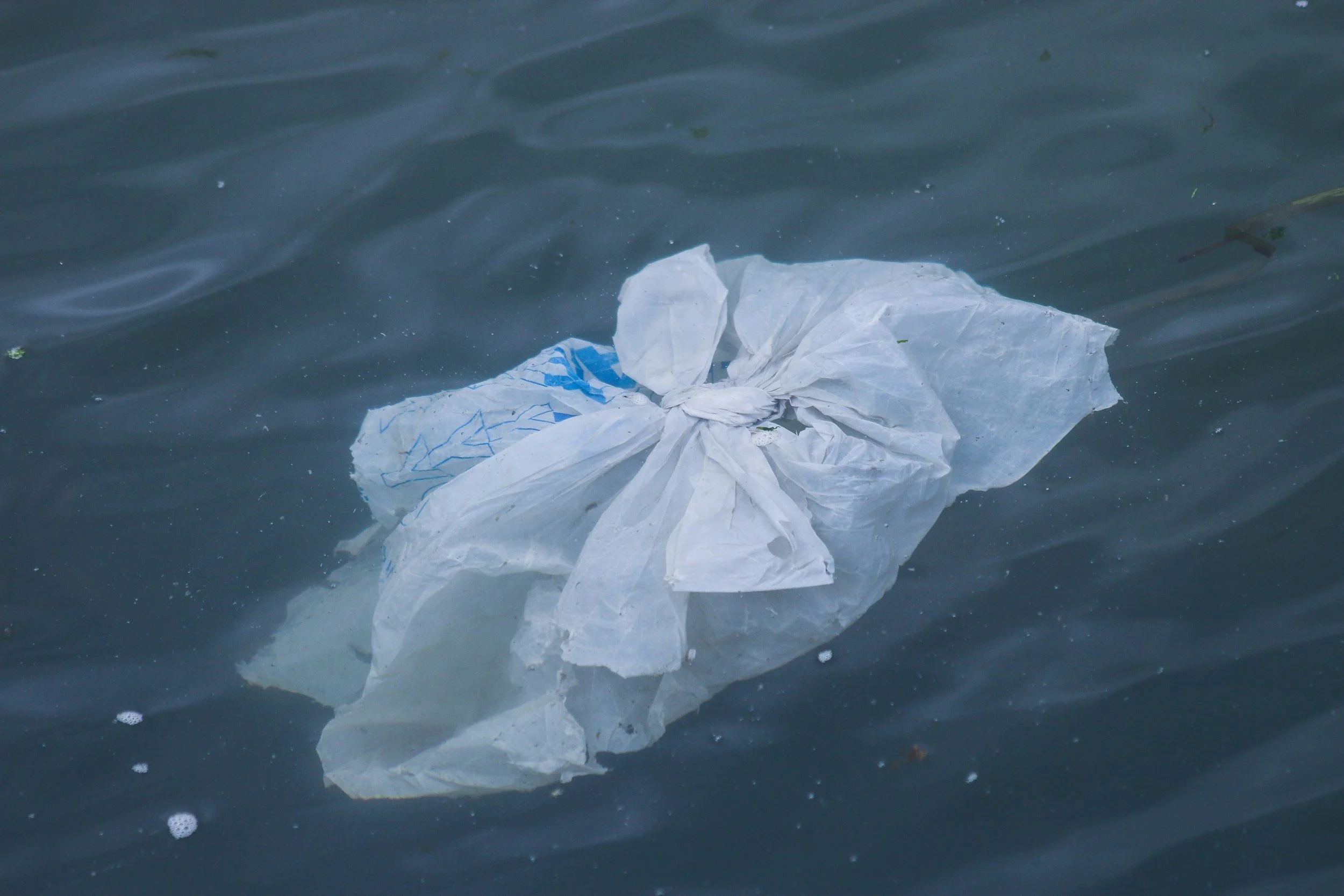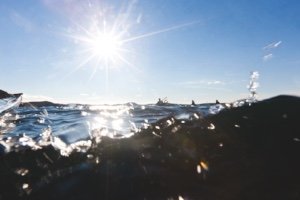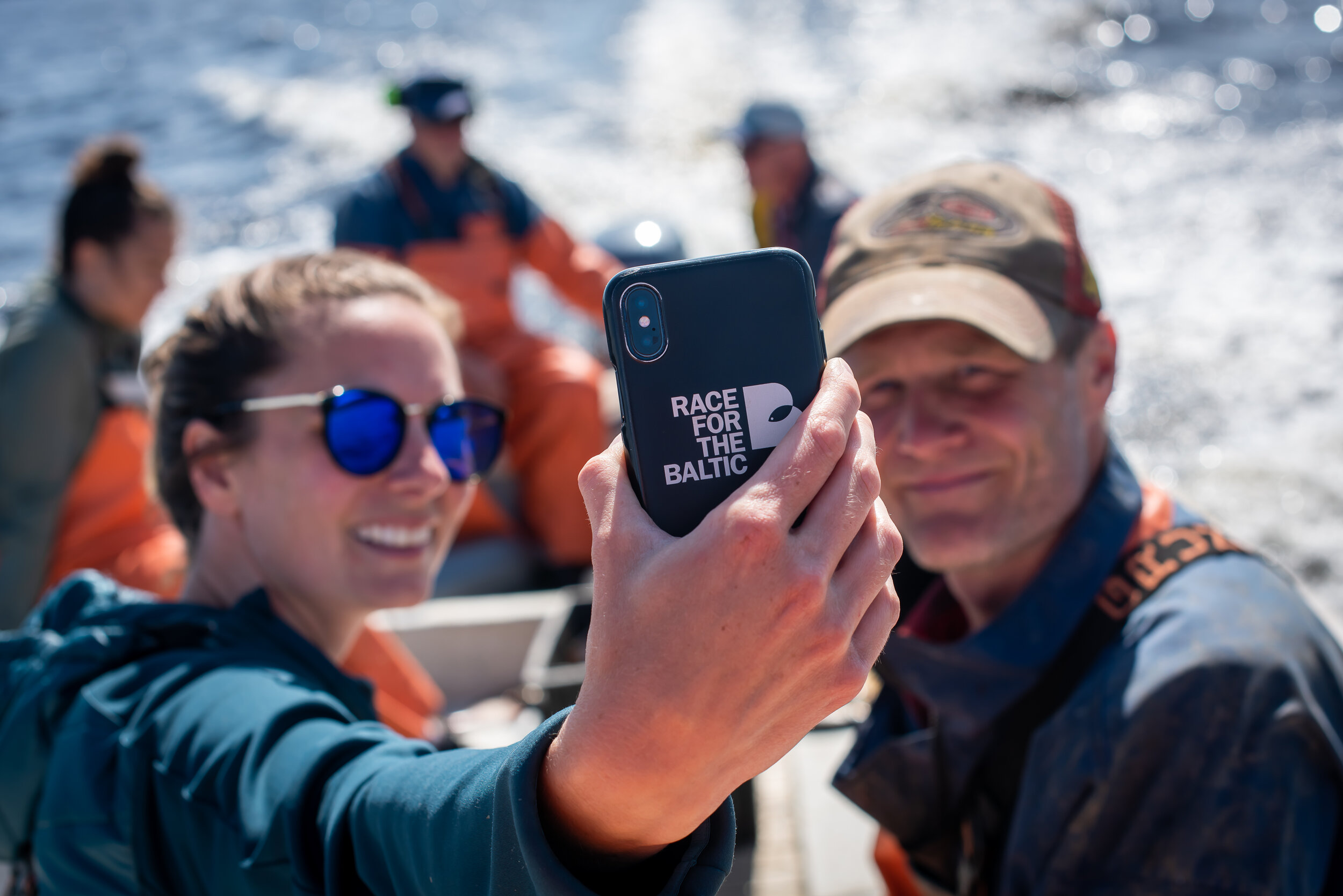State of the Baltic Sea
one of the world’s most unique and most polluted marine environments
Baltic Sea and its characteristics
This shallow, semi-enclosed sea is characterised by its brackish water – a mixture of salt and freshwater. The Baltic Sea’s low salinity is due to a high inflow of freshwater from rivers combined with minimal saltwater exchange with the North Sea. Its salinity is just one-tenth that of the open ocean, creating a brackish environment that supports a variety of life adapted to both fresh and saltwater conditions. This allows for a unique mix of species that wouldn’t typically coexist in fully saltwater or freshwater environments.
The Baltic’s geography further contributes to its unique status as a semi-enclosed sea with limited water exchange with the North Sea. Underwater ridges separating the deep basins cause saltier water to settle at the bottom, which remains isolated until occasional saline pulses from the North Sea refresh it. This stratification, or separation into layers, limits oxygen movement from the surface to deeper areas. It can take as long as 20–30 years for the water in the Baltic Sea to be replaced. These geographical and hydrological characteristics create a fragile ecosystem.
Environmental challenges
The limited exchange with the North Sea means that oxygen-rich water only sporadically reaches the Baltic’s depths. When these deep layers lose oxygen, “dead zones” develop, where marine life cannot survive.
Adding to this problem, oxygen-poor seabeds release phosphorus – a process known as internal loading, that intensifies eutrophication. Eutrophication, an excess of nutrients in the water, promotes algae blooms and can further deplete oxygen levels, creating a cycle that worsens the problem. Currently, around one fifth of the Baltic Sea’s deep seafloor lacks visible life due to low oxygen, spanning an area approximately the size of 1.5 Denmarks.
Map of the Baltic Sea – the numbers 1 to 9 identify the basins, as shown in table.
The Baltic Sea in numbers
12 000 years
418 690 km²
the Baltic Sea’s age
surface area
459 metres
8 000 km
maximum depth
shoreline length
450 km³
50 000
freshwater inflow / year
islands
0.1-0.2 %
51 metres
salinity
average depth
20 000 km³
30 years
people living in the drainage area
shipwrecks
for the entire water to change
water volume
90 million
100 000
State of the Baltic Sea
The Baltic Sea’s unique biodiversity has big ecological, economic and cultural importance for people in the region. There are multiple pressures that put the Baltic Sea’s ecosystem and hence human well-being at risk. Eutrophication is the most pervasive and serious environmental problem in the Baltic Sea. Other pressure that put the health of the Baltic Sea at risk are hazardous substances, underwater noise, the extraction of fish, physical disturbances and the introduction of non-indigenous species.
Figure 2. Extent of hypoxic and anoxic bottom water. Source: SMHI
Eutrophication
Eutrophication is the most critical environmental challenge facing the Baltic Sea. Driven by excess nutrient loads, the phenomenon leads to severe ecological imbalances, harming marine life and human activities alike.
-
Eutrophication occurs when excessive amounts of nutrients, such as nitrogen and phosphorus, are introduced into marine ecosystems. These nutrients act as fertilizers, boosting the growth of algae and other aquatic plants. While nutrients are essential for life, an overabundance can lead to environmental imbalances.
-
In the case of the Baltic Sea, eutrophication has been an ongoing problem for decades. Most of the nutrient inputs originate from human activities on land and on sea, reaching the sea by water and air. The main sources of nutrient pollution in the Baltic Sea include:
Agricultural Runoff
Agriculture, the largest human-caused contributor, releases significant nutrients into waterways through runoff from fertilizers and animal waste. This runoff causes eutrophication and low oxygen levels, which negatively affects marine life. Sustainable farming practices, including buffer zones and better manure management, are critical to reducing nutrient leakage into the sea.Wastewater Discharge
Despite improvements in wastewater management, many cities and towns still discharge inadequately treated wastewater, which carries excess nutrients. Urban runoff, from areas like streets and lawns, also contains pollutants that contribute to nutrient loads.Natural Background Sources
Natural Background significantly contributes to nutrient loading in the Baltic Sea through natural processes like soil erosion, rock weathering, and non-anthropogenic atmospheric deposition. These consistent, non-human inputs form the baseline nutrient load and must be distinguished from anthropogenic sources to effectively manage eutrophication.Other Sources:
Forestry
Stormwater runoff
Private sewage systems
Industrial processes, particularly pulp and paper production
Fish farming (causing localised nutrient loading)
Shipping activities (contributing to overall ecological stress and nitrogen deposition)
Addressing eutrophication in the Baltic Sea requires a comprehensive approach targeting these various sources, with a particular focus on sustainable agricultural practices and improved wastewater management.
-
The effects of eutrophication in the Baltic Sea are far-reaching, impacting the ecosystem, economy, and human well-being.
Algal Blooms
One of the most visible effects is harmful algal blooms, especially cyanobacteria. These blooms can cover vast areas of the sea, reducing light penetration and depleting oxygen levels in deeper waters. Some of these blooms are also toxic, posing risks to human health, tourism, and fisheries.Hypoxia and Dead Zones
Eutrophication also leads to hypoxic (low oxygen) conditions, as the decay of excess organic material consumes large amounts of oxygen. In severe cases, this results in anoxic areas, so called "dead zones", where oxygen levels are so low that most marine life cannot survive. Currently, around 20 percent of the Baltic Sea’s deep seafloor, an area approximately 1.5 times the size of Denmark, is anoxic. This makes the Baltic Sea home to seven out of the world’s ten largest marine “dead zones”.Loss of Biodiversity
Eutrophication disrupts marine ecosystems, favoring fast-growing species like algae while diminishing sensitive species, leading to biodiversity loss and habitat degradation.Impact on Fisheries
The decline in oxygen levels and the degradation of habitats, particularly spawning grounds for fish species, negatively affect fish populations, including commercially important species like cod. This leads to reduced catches, threatening the livelihoods of fishing communities around the Baltic.Economic and Social Costs
The economic costs are significant, with the tourism industry suffering from algae-covered beaches and the fishing industry impacted by declining fish stocks.
-
To combat eutrophication, HELCOM (Helsinki Commission) an intergovernmental organisation dedicated to protecting the Baltic Sea environment. Established in 1974, it brings together the nine countries bordering the Baltic Sea and the EU to collaborate on environmental protection efforts. HELCOM developed the Baltic Sea Action Plan (BSAP), which provides a comprehensive strategy for reducing nutrient loads and restoring the health of the Baltic Sea. The BSAP sets specific targets for reducing nutrient inputs, protecting marine species, and promoting sustainable use of the sea.
A key part of this strategy is the concept of Maximum Allowable Input (MAI), which sets science-based limits on the amount of nutrients that can safely enter the Baltic Sea without causing eutrophication. Since the 1980s, the annual phosphorus inflow has decreased by over 40,000 tonnes. However, an additional reduction of 5,500 tonnes is still required to reverse the trend.
By establishing MAI limits, the BSAP encourages countries around the Baltic to implement measures such as improved wastewater treatment, sustainable agricultural practices, and effective nutrient management policies to reduce nutrient runoff and atmospheric deposition. This coordinated approach aims to achieve a Baltic Sea with balanced nutrient levels, preventing the harmful algal blooms and hypoxia that result from excessive nutrient loads.
Through coordinated regional efforts like the HELCOM Baltic Sea Action Plan, there is hope for reducing nutrient pollution and restoring the Baltic Sea’s ecological balance.
Green algae blooms swirling around the Baltic Sea. Photo: European Space Agency
Figure 3. Source: PLC 8 Results
Other Baltic Sea pressures and key industries
Planetary Boundaries and the Baltic Sea
A problem of global scope
The concept of planetary boundaries outlines nine key thresholds critical for maintaining Earth's stability. These boundaries define the safe operating space for humanity. Crossing them risks pushing ecosystems toward irreversible changes.
As of the latest Planetary Boundaries assessment, humanity has exceeded six of the boundaries. Among these are areas like biochemical flows of nitrogen and phosphorus, climate change and biodiversity loss — issues that are particularly relevant for the Baltic Sea.
What affects the Baltic Sea on a regional level is interconnected with the Planetary Boundaries and environmental issues on a global level. That is why efforts to restore the Baltic Sea’s ecological balance, like the reduction of nutrient loads, are critical for safeguarding the environment regionally and globally.
The Planetary Boundaries over time
Climate change and the Baltic Sea
Global warming is causing water temperatures to rise - even faster in the Baltic Sea than in most other seas. Already today, this profoundly affects the sea’s ecosystems, its water quality, and the coastal communities. The effects of climate change are expected to worsen in the coming years and the need for stronger actions for the health of the Baltic Sea is bigger than ever.
Increases eutrophication
Higher average precipitation will increase nutrient run-off from agricultural and urban areas. Nutrient discharge and rising water temperatures again promote algae growth and accelerate eutrophication in the sea.
Increases the risk of biodiversity loss
Warmer temperatures, decreasing ice cover and possible changes in salinity can alter the distribution and behavior of marine species profoundly. This can disrupt the function of the food web and the marine ecosystem leading to changes in productivity and resilience.
Solutions for a healthy Baltic Sea
The Baltic Sea's health is one of the most urgent environmental challenges for the nine surrounding countries, affecting diverse sectors from fishing to tourism. Addressing these issues requires robust international cooperation and immediate action.
The sea is essential for millions who depend on it for livelihoods and recreation. However, the ecosystem's deterioration threatens these benefits. Revitalising the Baltic Sea can enhance its biodiversity and boost its role in absorbing greenhouse gases, crucial for mitigating climate change. We know enough to act – it's time to focus on concrete solutions.
Human activities put intense pressure on the Baltic Sea. With 90 million people depending on it for industries like shipping, tourism, and fishing, the sea is essential for local economies. However, this reliance comes at a cost to the ecosystem, requiring sustainable management to balance economic growth with environmental protection.
Investing in the Baltic Sea's restoration not only benefits the environment but also presents significant economic opportunities. A healthier Baltic could generate €32 billion annually and create up to 550,000 jobs by 2030.
-
The global blue economy is valued at around $2.5 trillion annually, ranking it as the world’s 7th largest economy . It includes industries such as fisheries, aquaculture, maritime transport, and offshore renewable energy. The blue economy is expected to double in size by 2030 compared to 2010 levels.
Beyond its economic worth, the blue economy also supports over 260 million jobs worldwide in fisheries and aquaculture, contributing $100 billion annually to the global economy.
Blue economy is an important part of the economy in the Baltic Sea Region, directly employing more than 700,000 persons. By promoting a sustainable blue economy, stakeholders in the Baltic Sea Region can work towards restoring the sea's health while simultaneously fostering economic growth and innovation. This approach offers a promising path for balancing environmental protection with economic development, making it a key solution for the long-term sustainability of the Baltic Sea.
-
In the leaflet Key measures for the Baltic Sea researchers and experts from the Stockholm University Baltic Sea Centre present some key measures to improve the environment of the Baltic Sea, from the Bothnian Bay to the Kattegat.
Funding
If your municipality or start-up wants to work on improving the water quality and ecological status of the Baltic Sea, you can access various grants and funding sources that offer the best potential.
The Swedish Agency for Marine and Water Management (SwAM/HaV) provides a comprehensive platform for grants, calls, and funding opportunities aimed at improving marine and freshwater environments. Whether you are working on local water quality projects, reducing nutrient runoff, or restoring ecosystems, SwAM offers tailored support to help you achieve impactful results. Visit SwAM dedicated page to explore funding options, application guidelines, and current calls for proposals.
In addition, the brochure "Var finns pengarna?" (Where’s the Money?) from the County Administrative Board of Sweden provides an overview of funding opportunities for environmental and water-related projects. It is aimed at municipalities, organisations, landowners, and businesses working to improve water quality and ecosystems.
What can I do to help?
Everyone can contribute to improving the Baltic Sea’s health:
Reduce Water Pollution: Use eco-friendly cleaning products and minimise fertilizer use.
Conserve Water: Lowering water usage reduces wastewater entering the sea.
Support Sustainable Seafood: Choose certified sustainable seafood and avoid overfished species.
Participate in Cleanups: Join local beach cleanups and volunteer for restoration projects.
Raise Awareness: Engage in discussions about the Baltic Sea’s challenges and share information on sustainable practices.
Baltic Sea Day: engage in an annual day of celebration in honour of the sea.
By making environmentally conscious choices and advocating for sustainable policies, individuals can play a crucial role in protecting the Baltic Sea for future generations.
Sources
Helcom "State of the Baltic Sea"
Helcom Thematic assessment of eutrophication 2016-2021
Stockholm University Baltic Sea Center “Key measures for the Baltic Sea”
Helcom “Baltic Sea Action Plan” 2021 update
John Nurminen Foundation 2024
Katherine Richardson et al., Earth beyond six of nine planetary boundaries. Sci. Adv. 9, eadh2458 (2023)
Video: Deep Sea Reporter
Page updated: May 2025














